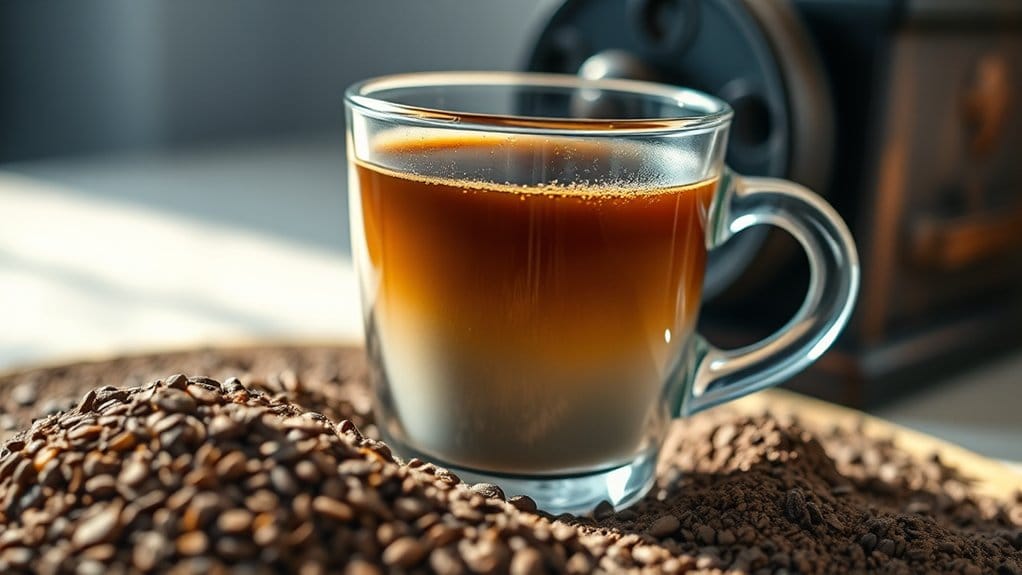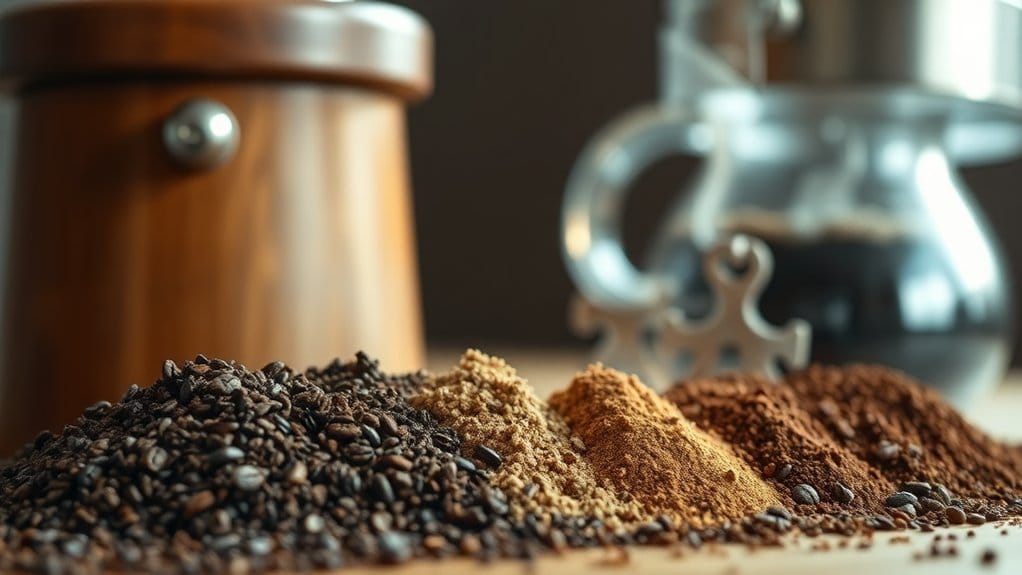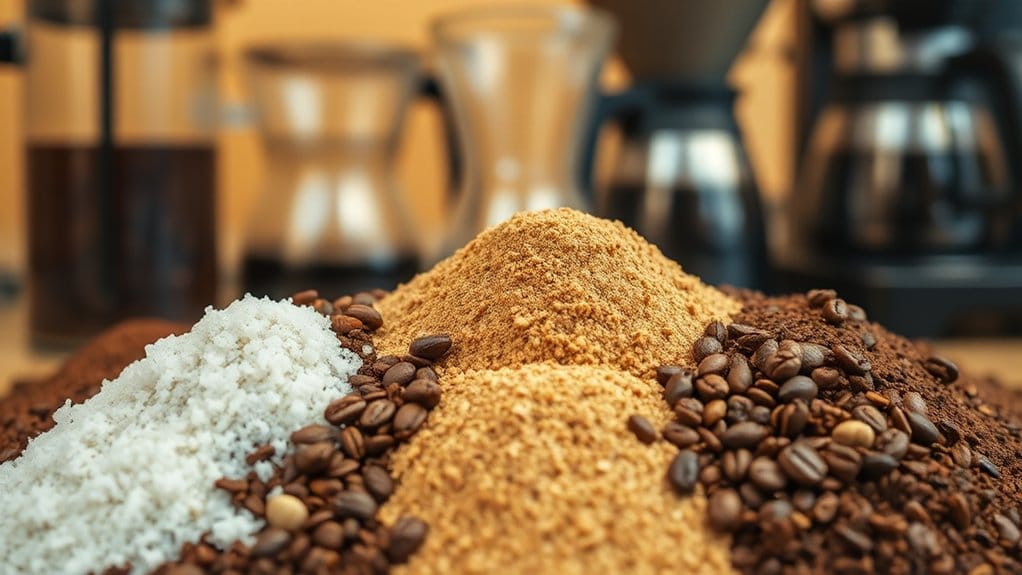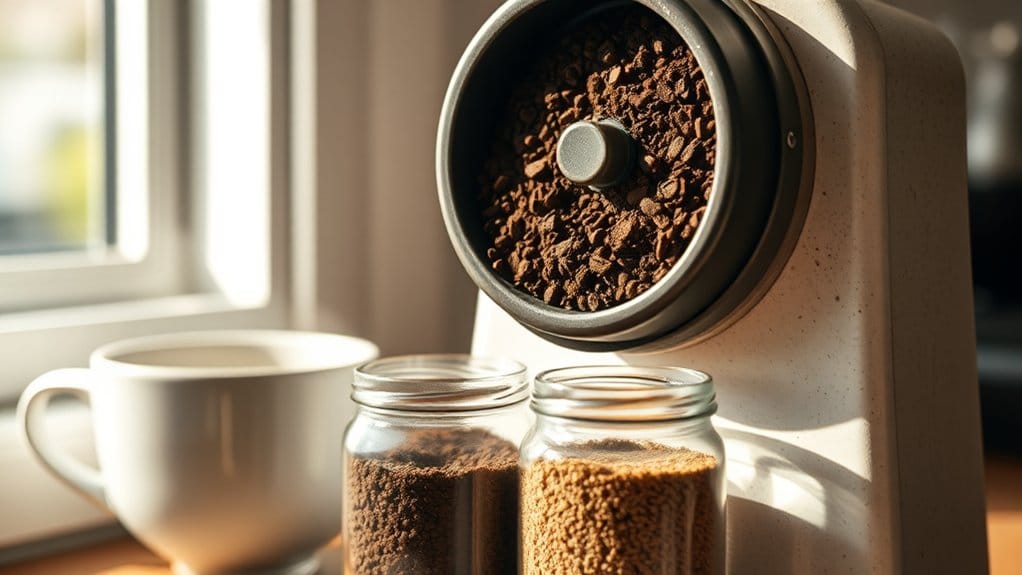Physical Address
304 North Cardinal St.
Dorchester Center, MA 02124
Physical Address
304 North Cardinal St.
Dorchester Center, MA 02124

The grind size of your coffee beans can totally change your brew’s flavor. If you go fine, you might get bright, zesty notes, but watch out for bitterness! Coarser grinds bring out smoothness and sweetness, though too coarse can lead to a weak cup. A burr grinder is your best friend for consistency, making every sip delightful. Curious about how different brewing methods affect flavors? There’s more to discover, so let’s keep this coffee expedition going!

When you think about brewing your favorite cup of coffee, it might surprise you just how much grind size matters. Envision this: a finely ground espresso bursting with bold flavor, compared to a coarsely ground French press, slowly revealing nuanced notes.
With a finer grind, you’re ramping up extraction speed, pulling out rich oils but as well risking bitterness if you’re not careful. Inconsistent grind size can also cause under-extraction, which might lead to an unbalanced cup. On the flip side, a coarser grind takes its sweet time. It teases out brighter, fruitier flavors but can leave your cup feeling weak if not brewed long enough. Total dissolved solids measurement indicates the optimal grind size for coffee extraction, enhancing the flavor profile you experience in your cup. Additionally, selecting the right grinder type is crucial for achieving that perfect consistency that enhances extraction and flavor development.
Grind consistency plays an essential role in brewing a fantastic cup of coffee, making it as important as the beans themselves. When every particle’s about the same size, you enjoy uniform extraction, resulting in a balanced flavor. Consistent grind size enhances extraction efficiency, allowing the perfect balance between sweetness and bitterness. Imagine sipping a cup where the bitterness doesn’t overpower the sweetness—pure bliss! Inconsistent grinds lead to over-extraction for some whereas leaving others sad and under-extracted. No one wants a cup like that.
To achieve that dreamy consistency, invest in a burr grinder; they’re like the trusty sidekick of home brewers. Understanding that grind size significantly affects flavor extraction ensures you can make informed adjustments. Remember, a little maintenance goes a long way! So, make it a habit to calibrate your grind and celebrate the delightful aromas that jump from your coffee. Additionally, grind size plays a crucial role in matching brewing methods to personal taste, making experimentation key to perfecting your brew.
Cheers to brewing magic!

Finding the right grind size is like picking the perfect outfit for a specific occasion—it makes all the difference!
When you’re brewing with a French press, opt for a coarse grind, about the size of sea salt. This way, you get rich flavors without bothersome sediments sneaking through. A consistent coarse grind is essential for optimal flavor extraction during the brewing process.
For cold brew, think extra-coarse. That slow steeping will have you savoring a smooth cup after 12 hours! Remember, using the right grind size helps ensure consistent taste.
Now, if you’re using a drip or pour-over method, medium to medium-coarse grinds strike that perfect balance.
Finally, for espresso lovers, fine grinds are crucial—like powdered sugar—for quick, intense shots.
Choosing the right grind isn’t just science; it’s an art, and you’re the artist!
Acidity, sweetness, and complexity come together to create a delightful experience in each cup. When you grind coffee finer, you kick up the acidity, bringing bright, zesty notes like citrus to life. Conversely, coarser grinds can dull those flavors, leaving you with a flat brew. Sweetness emerges when you get the grind just right, unlocking sugars that sway on your palate. Yet, if your grind’s too coarse, your cup might taste more like sad, watered-down coffee. Finding that sweet spot of grind size is your key to a complex, balanced cup. Additionally, the brewing methods you choose also impact how acidity is perceived in your coffee. Who wouldn’t want to sip a masterpiece, right?

Mastering grind size is an essential step if you want to raise your brewing game at home. Start by using the right grind for your method—extra coarse for cold brew, coarse for French press, and fine for espresso.
Think of it like selecting the perfect outfit; the right fit makes all the difference!
Consistency is key. Invest in a burr grinder, as it produces uniform coffee particles, ensuring balanced extraction. Just remember, grinding just before brewing keeps the flavors fresh and lively.
Adjusting your grind size can easily transform a mediocre brew into a delightful cup. It’s your brewing playground! Additionally, using the correct water temperature during brewing is crucial for optimal flavor extraction.
Humidity affects your coffee grind size by causing clumping, which leads to inconsistent extraction. You’ll need to adjust grind settings based on humidity levels to achieve balanced flavors and ideal brewing results.
You can technically use a spice grinder for coffee, but you won’t get the consistent grind size needed for ideal flavor. It’s better to invest in a dedicated coffee grinder for the best brewing results.
If you’re tasting a strong, bitter flavor that lingers unpleasantly, you’ve likely over-extracted your coffee. The mouthfeel may feel dry or astringent, and unique flavors can become masked, leaving your brew flat and unexciting.
Coffee oils markedly impact your grind size choices. If you want rich, smooth flavors, adjust your grind to balance oil extraction. Too fine can lead to bitterness; too coarse might underdeliver on aroma and richness.
Yes, there are health implications with grind sizes. Finer grinds can increase caffeine and harsh flavors, whereas coarser ones may lower caffeine content, reducing anxiety risks. Choosing the right grind helps optimize coffee’s health benefits.